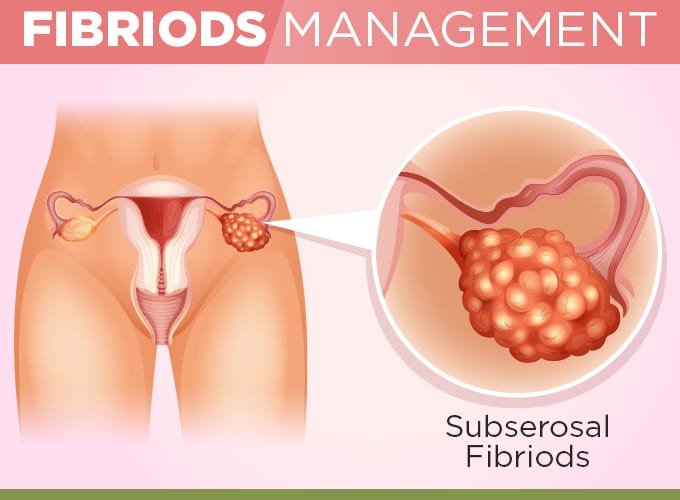What are Uterine Fibroids?
Also known as leiomyomas or myomas, uterine fibroids are noncancerous growths of the uterus that often appear in the uterus during the childbearing period. It has no connection to uterine cancer.
Fibroids range from microscopic to bulky growth that can distort and enlarge the uterus. You can have a single fibroid or multiple ones. Most women have a growth of fibroids once in their lifetime. But, they are hard to diagnose as they usually have no symptoms.

Symptoms, Causes and Types of Fibroids
In a few women where the symptoms of fibroids are visible they are:
- Heavy menstrual bleeding
- Menstrual periods lasting more than a week
- Pelvic pressure or pain
- Frequent urination
- Difficulty emptying the bladder
- Constipation
- Backache or leg pains
Fibroids are generally classified into three types:
- Intramural fibroids grow within the muscular uterine wall.
- Submucosal fibroids bulge into the uterine cavity.
- Subserosal fibroids project to the outside of the uterus.
The actual causes of fibroid growth has not been found by experts, but some of the factors which are thought to cause uterine fibroids are:
- Genetic changes.- Many fibroids contain changes in genes that differ from those in typical uterine muscle cells.
- Hormones – Oestrogen and progesterone are the two hormones that stimulate development of the uterine lining during each menstrual cycle in preparation for pregnancy. Fibroids contain more oestrogen and progesterone receptors than typical uterine muscle cells do.
- Extracellular matrix (ECM) – ECM is the material that makes cells stick together, like mortar between bricks. ECM is higher in fibroids and makes them fibrous.
Small fibroids usually don’t have much effect on pregnancy. However, it’s possible that fibroids — especially submucosal fibroids — could cause infertility or pregnancy loss.
Fibroids may also raise the risk of certain pregnancy complications, such as placental abruption, foetal growth restriction and preterm delivery.

Diagnosis and Treatment
Uterine fibroids are frequently found incidentally during a routine pelvic exam. If you have symptoms then you might have to undergo tests such as:
- Imaging Test such as Ultrasound, MRI
- Hysterosonography which is also called a saline infusion sonogram, uses sterile salt water (saline) to expand the uterine cavity, making it easier to get images of submucosal fibroids.
- Hysterosalpingography uses a dye to highlight the uterine cavity and fallopian tubes on X-ray images. This test can help your doctor determine if your fallopian tubes are open or are blocked and can show some submucosal fibroids.
- Hysteroscopy includes inserting a small, lighted telescope called a hysteroscope through your cervix into your uterus. Your doctor then injects saline into your uterus, expanding the uterine cavity and allowing your doctor to examine the walls of your uterus and the openings of your fallopian tubes.
- Complete blood count (CBC) testing to determine if you have anaemia because of chronic blood loss and other blood tests to rule out bleeding disorders or thyroid problems.
The treatment of Fibroids may include medications, non-invasive or minimally invasive surgery or laparoscopic surgery.
Medications for uterine fibroids target hormones that regulate your menstrual cycle, treating symptoms such as heavy menstrual bleeding and pelvic pressure. They don’t eliminate fibroids but make them shrink.
- Gonadotropin-releasing hormone (GnRH) agonists are one of the common medications used to treat fibroids. They do so by blocking the production of oestrogen and progesterone, putting you into a temporary menopause-like state. As a result, menstruation stops, fibroids shrink and anaemia often improves.
- Uterine artery embolization is a popular minimally invasive surgical procedure to treat fibroids. Small particles (embolic agents) are injected into the arteries supplying the uterus, cutting off blood flow to fibroids, causing them to shrink and die.
- In Laparoscopic or robotic myomectomy, the surgeon removes the fibroids, leaving the uterus in place. A person may opt for a laparoscopic or robotic procedure if the fibroids are few in number.
- Hysteroscopic myomectomy is a surgical procedure used if the fibroids are contained inside the uterus (submucosal). Your surgeon accesses and removes fibroids using instruments inserted through your vagina and cervix into your uterus.
Dr Puneet’s fertility clinic is well equipped with all the infrastructure and facilities to treat uterine fibroids and to perform complex surgeries like laparoscopy and hysteroscopy. All the treatment at the clinic is done under the guidance of a team qualified doctors and medical professionals.
Meet Our Professional


